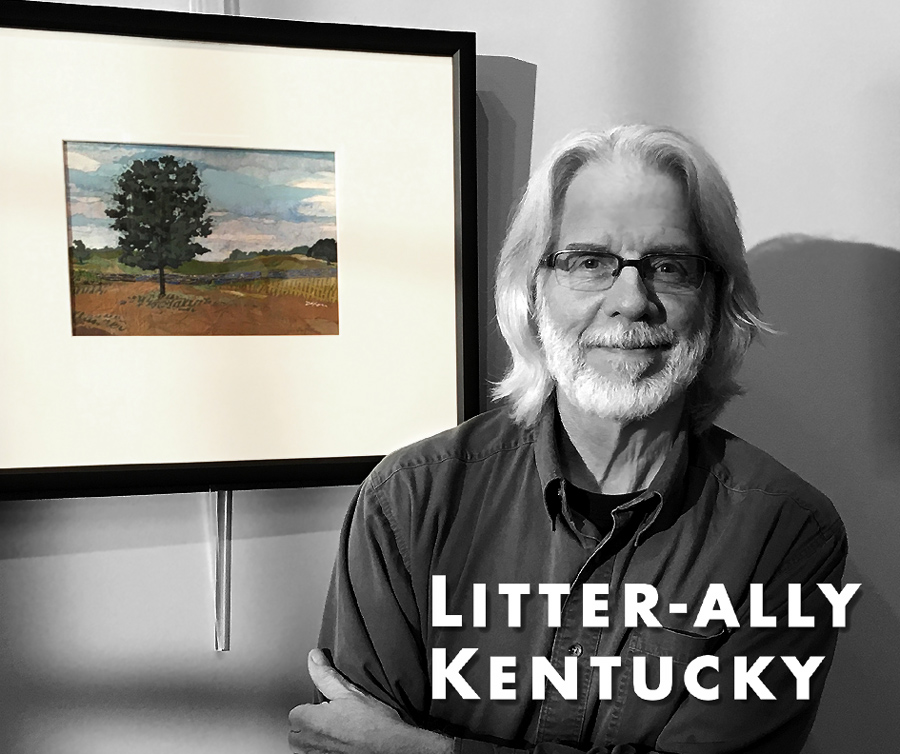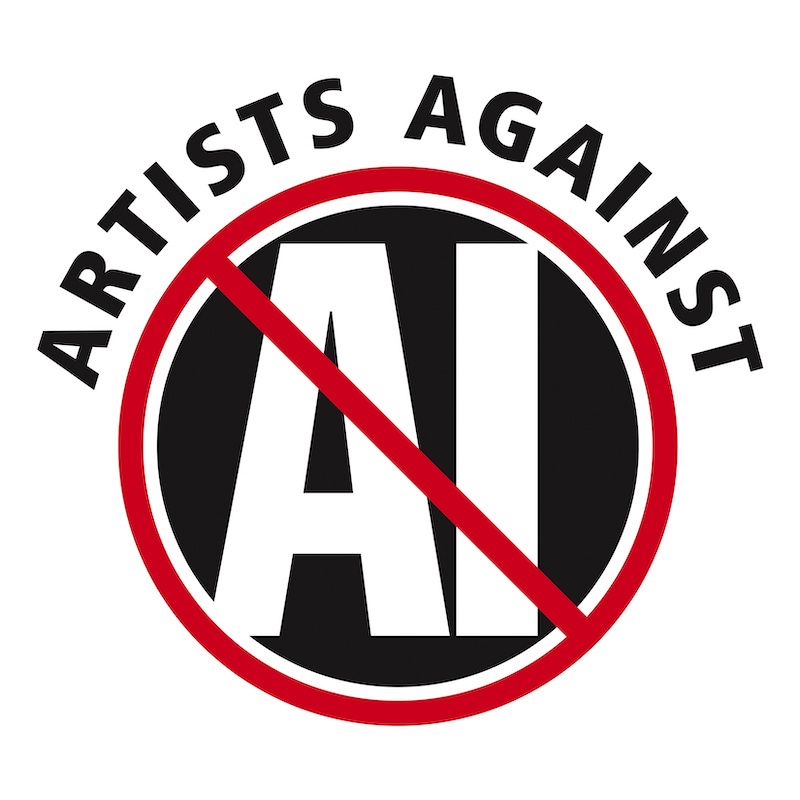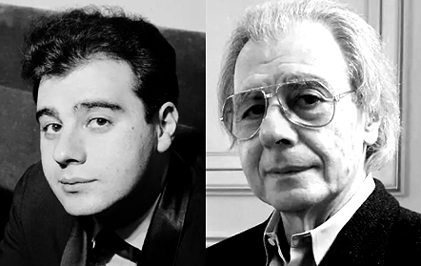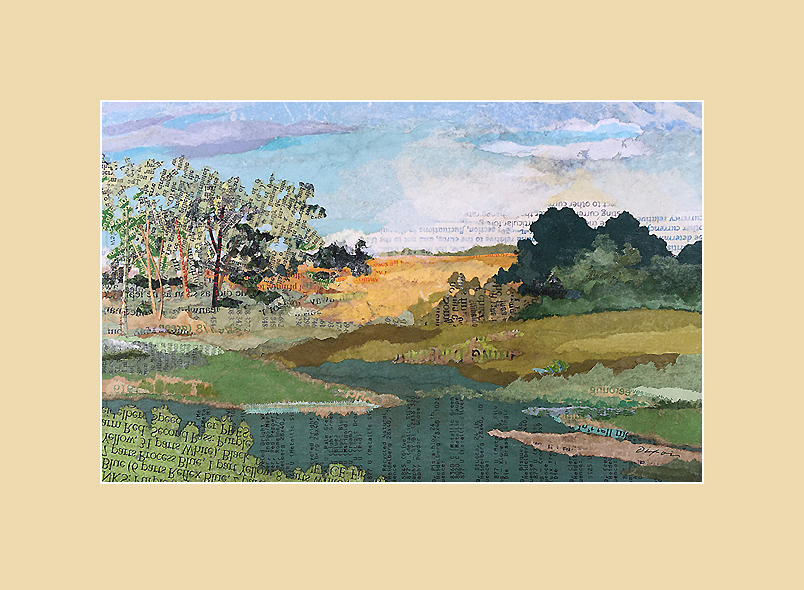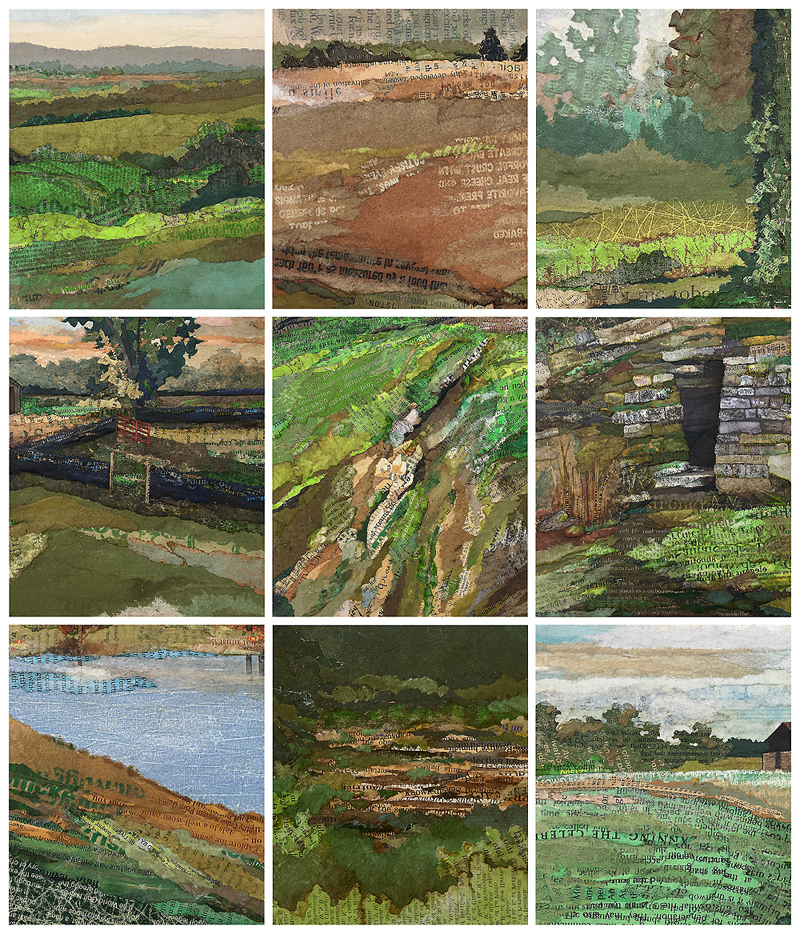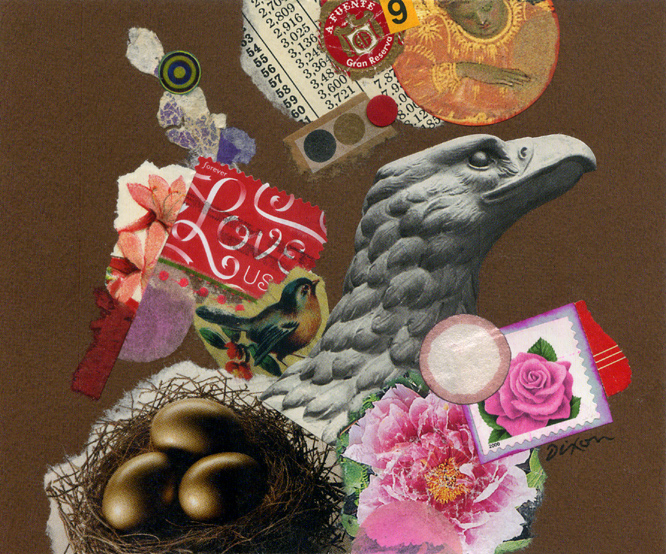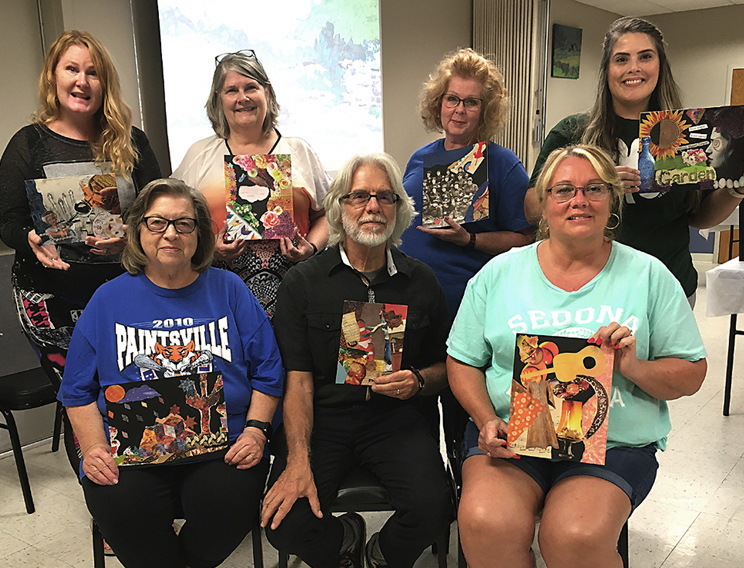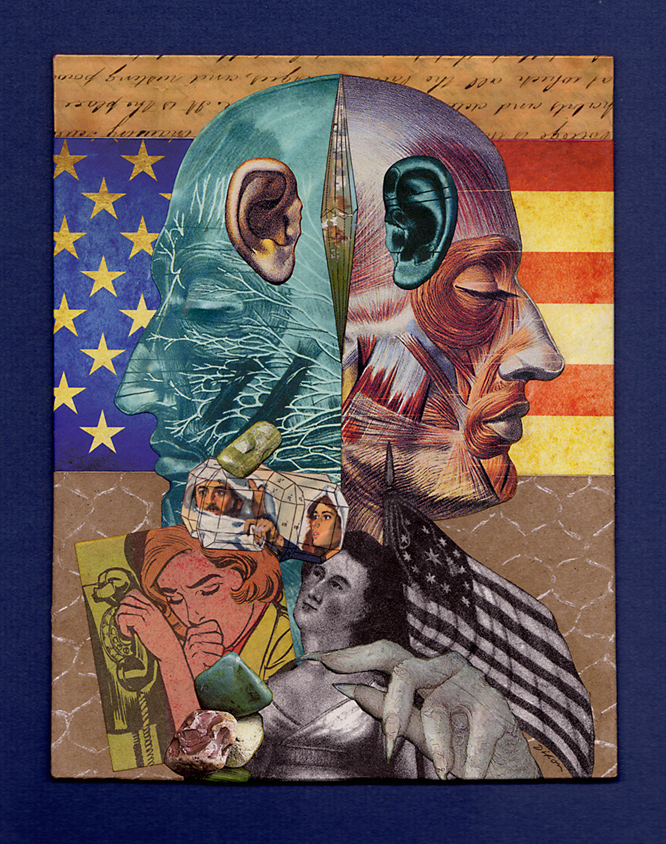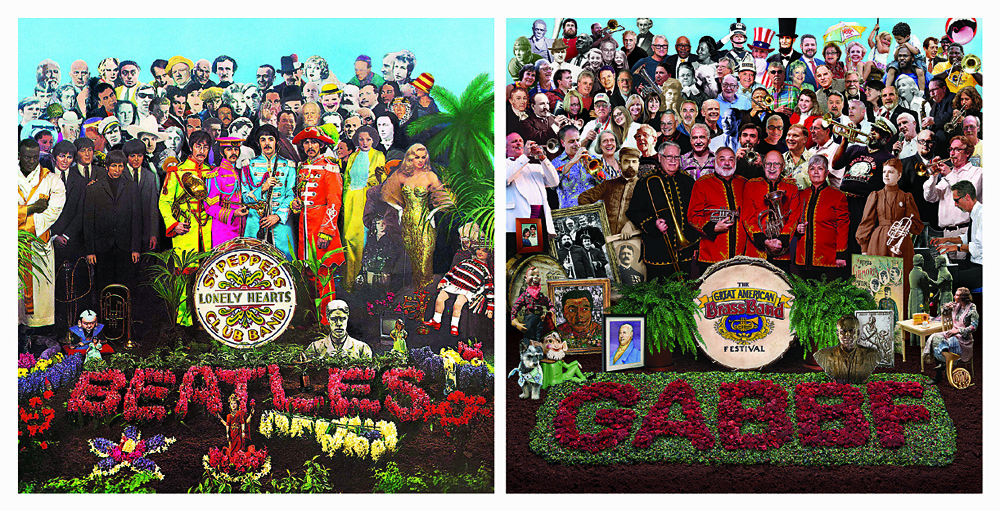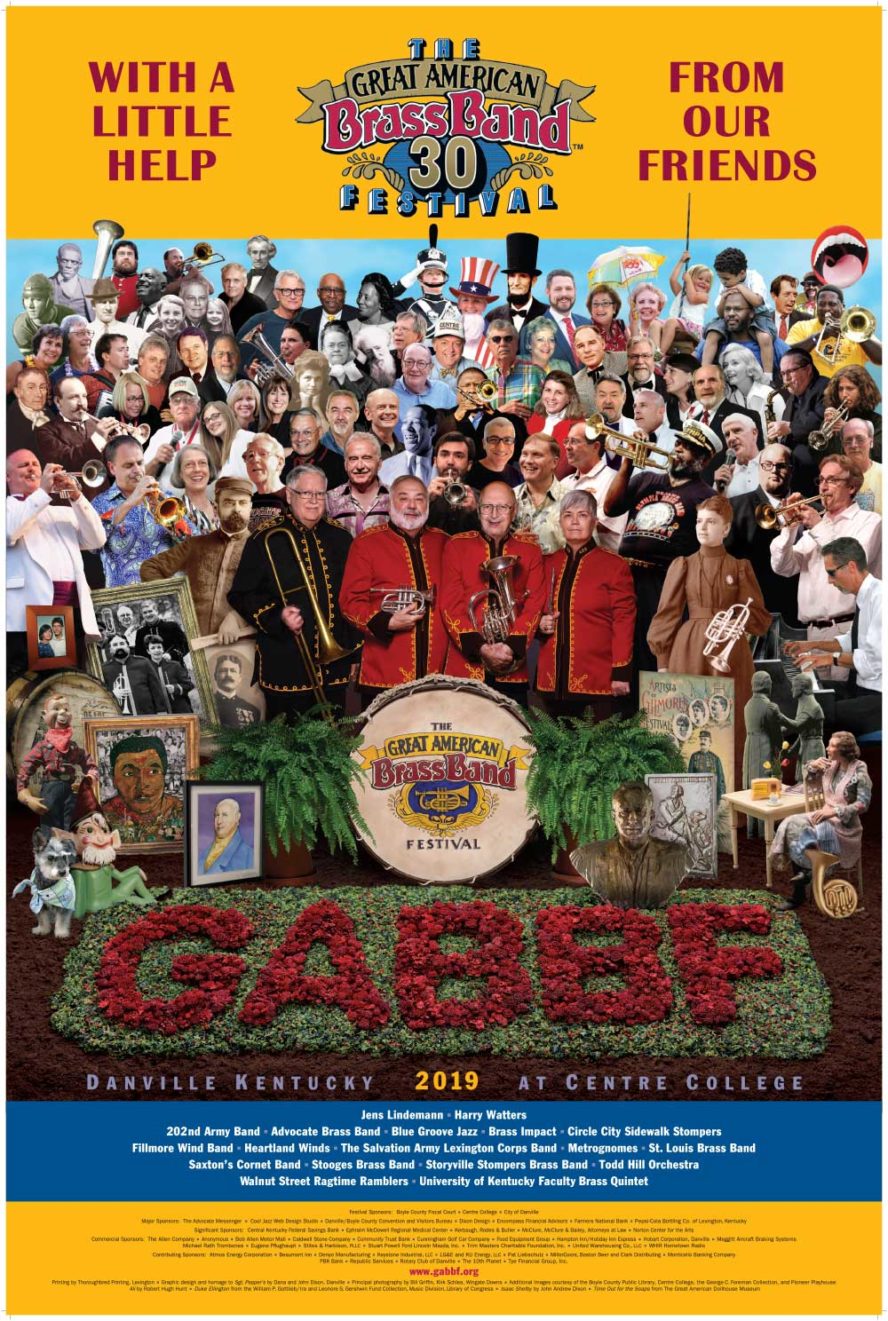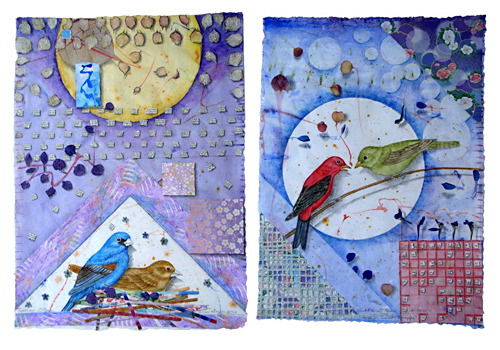“Any composer, painter or sculptor will tell you that inspiration comes at the eighth hour of labour rather than as a bolt out of the blue. Get our vanities and preconceptions out of the way and do the work in the time allotted.”
— John Williams
Archive for the ‘Creativity’ Category
Wednesday, December 10th, 2025
Exhibition at Art Center of the Bluegrass in October
Thursday, September 4th, 2025
“Rooted in visual design and inspired by the avant-garde history of collage, LITTER-ALLY KENTUCKY is a compelling body of work that transforms discarded materials into powerful statements on beauty, environment, and belonging. Created entirely from recycled and found objects — including ruined book pages, used tea bags, and fragments of roadside litter — these intricate collage landscapes offer…” READ MORE:
Saturday, July 12th, 2025
“Writing, like all creative forms, is a human endeavour. At its best it is pulled up from the soul and put down on the page, or the screen. We all use ‘tools’ of some kind to do this, like the keyboard I am now writing on. But AI is different. It does not help you to do your job; it does your job for you. It sucks up from the worldwide web the usings and doings and scrapings of the already-created and it rearranges them, pretending all the while that it has ‘created’ them itself. It imitates reality but can never replace it. It is, at root, a shabby, boring and actually evil thing. It is the end of art.”
— Paul Kingsnorth, 7/12/25
Saturday, June 28th, 2025
Lalo Schifrin
1 9 3 2 – 2 0 2 5
the incomparable maestro
R
I
P
View my collage landscape galleries —
Thursday, March 6th, 2025
Recent Landscapes
As I continue to focus
on “painting in papers”
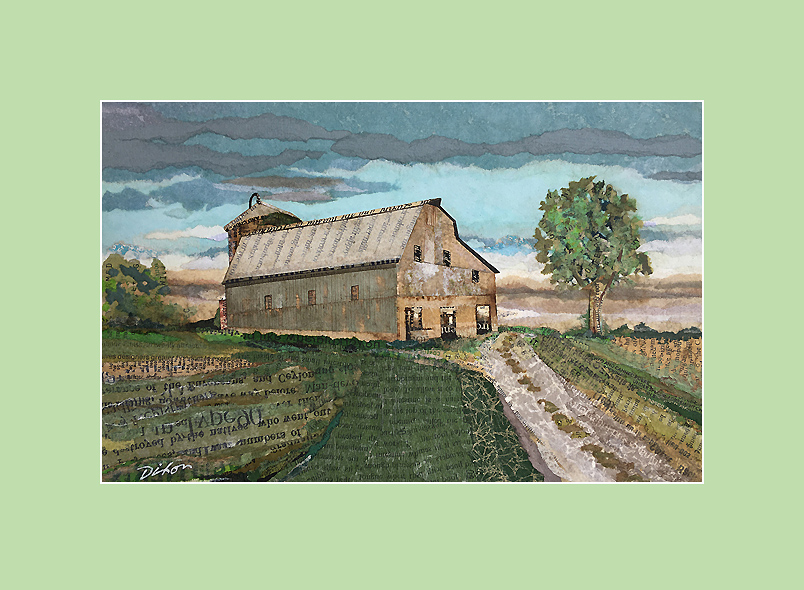
LITTER-ALLY KENTUCKY
Also available as
premium giclée prints
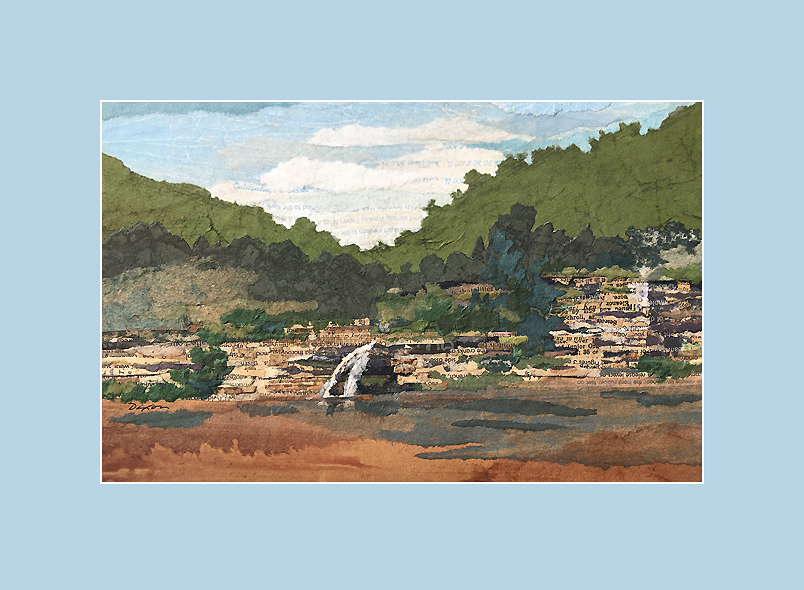
A Change of Seen
When I first took paper
and paste outside
Those in most need of Thy mercy . . .
Sunday, January 12th, 2025Facing another March X challenge!
Thursday, February 29th, 2024“Everyone has now seen that pandemics are another way for the military, intelligence, and public health services to expand their budgets and their power. In 2020, public health, defense, and intelligence agencies weaponized a [Covid-19] pandemic, resulting in unprecedented profits to Big Pharma and the dramatic expansion of the security/surveillance state, including a systemic abandonment of constitutional rights — effectively a coup d’état against liberal democracy globally.”
– Robert F Kennedy, Jr / The Wuhan Cover-Up: And the Terrifying Bioweapons Arms Race (Kindle edition, p. 385)
I am recovered from an unnamed health ordeal that hit me the day after Christmas and lasted a month before I felt reasonably well. Then another month before I felt like myself. My recent article in Clandestiny will be all I say about it any time soon. So now it’s Leap Day and the eve of another March X. I won’t be recording regular notes about my heightened activity this time. Priorities to be confronted: 1) completing a “legacy collage” commission for a Dominican Sister of Peace: 2) building a greenhouse in the backyard of the Town House; 3) preparations for a new gardening season; 4) physical conditioning to ready myself for a decent bicycling program in 2024. Be seeing you in April!
The benefit of cropping exercises
Wednesday, December 20th, 2023“Accepting the familiar is the enemy of seeing… Seeing takes work and patience and concentration and focus otherwise we are always walking around in a fog only seeing what we think we know but not actually seeing anything at all.”
— Cecil Touchon
Cropping exercises always offer some insights about internal composition and color relationships. The more I internalize spatial decisions and color judgments, the less reason there is to think about them when I seek spontaneity in pasting ingredients. Please take a look at the entire collection that I call LITTER-ALLY KENTUCKY.
Nine Details, LITTER-ALLY KENTUCKY
collage en plein air by J A Dixon
giclée prints of originals are available
The world without her remains a world full of Mombo.
Sunday, January 1st, 2023This past month was dominated by the earthly departure of my mother. The role she played in my becoming an artist and the approach I bring to my practice cannot, and should not, 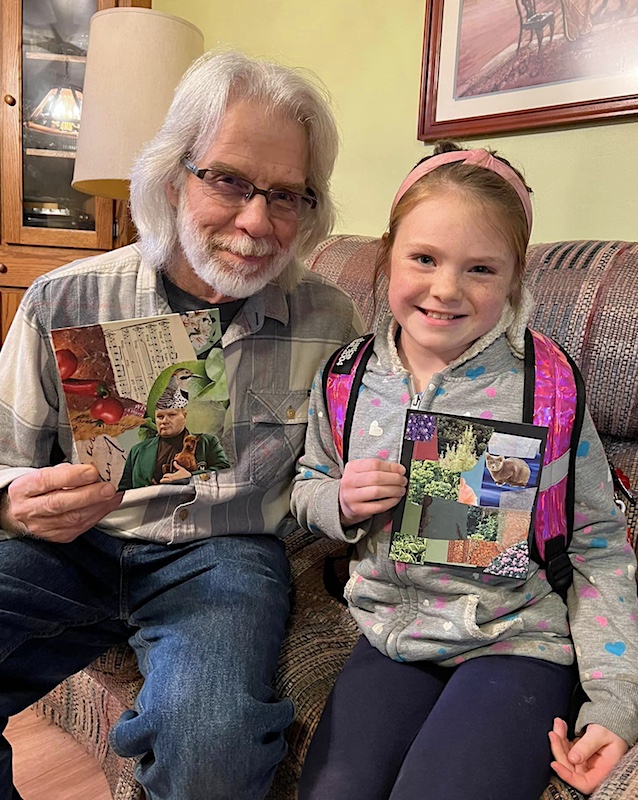 be understated. What a debt I owe to her, and to pay it forward will require that I live as long as she! I might’ve started “giving back” much earlier, if it had been my basic nature. I can be a quick study for most things, but it often takes me far too long to learn the rest, especially when it involves stepping beyond my own creative urge. Her life was a lesson in putting others before self. In order to support her parents’ household in a world at war, she turned down a full scholarship to the same University of Cincinnati that I would eventually attend. Decades later, in a nest recently emptied of seven children, and just as she was about to explore her own personal interests, she followed her family to a remote part of a rural Kentucky county. As a widow, she built an ethical foundation for a land-based legacy that is now set to endure for generations. When she faced a grim medical prognosis that would break the spirit of others, she maintained a zest for life, an obvious concern for how it might affect others, and an astonishing diligence to push back against it. The world of my youth had shouted, “Be cynical, or pessimistic, or both,” but she would always be my reliable source of optimism, like a spring which never dries up.
be understated. What a debt I owe to her, and to pay it forward will require that I live as long as she! I might’ve started “giving back” much earlier, if it had been my basic nature. I can be a quick study for most things, but it often takes me far too long to learn the rest, especially when it involves stepping beyond my own creative urge. Her life was a lesson in putting others before self. In order to support her parents’ household in a world at war, she turned down a full scholarship to the same University of Cincinnati that I would eventually attend. Decades later, in a nest recently emptied of seven children, and just as she was about to explore her own personal interests, she followed her family to a remote part of a rural Kentucky county. As a widow, she built an ethical foundation for a land-based legacy that is now set to endure for generations. When she faced a grim medical prognosis that would break the spirit of others, she maintained a zest for life, an obvious concern for how it might affect others, and an astonishing diligence to push back against it. The world of my youth had shouted, “Be cynical, or pessimistic, or both,” but she would always be my reliable source of optimism, like a spring which never dries up. 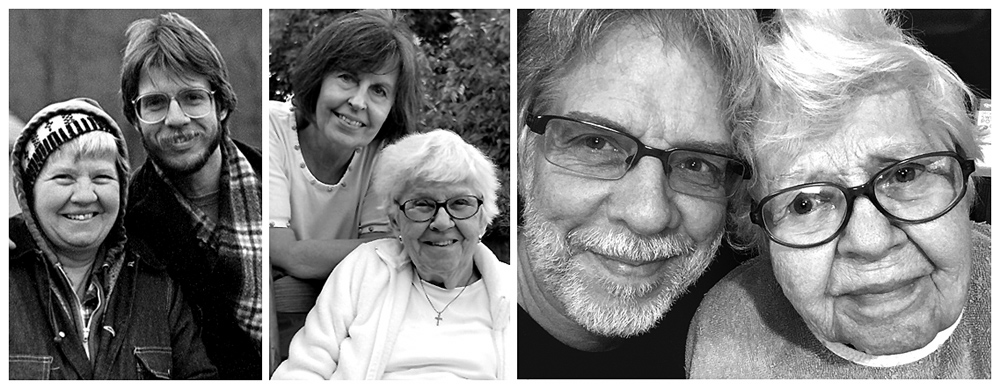 I could’ve become a quitter early on, but she helped me to overcome discouragement born of self-doubt and to fulfill commitments. If something is worth doing, it’s worth doing well. Why not always do your very best? And then you will automatically get better. Along with my siblings, everything was done to provide the care she needed to continue living at home, until it became no longer possible. Those years — what could be mistakenly judged as sacrificial — strengthened our family bond in a way that will last us for the duration. To separate that from my activity as an artist was unnecessary at the time and foolhardy in hindsight. Above and beyond the value of artisanship, she taught me that a creative life without love for others is devoid of meaning. Of all the souls I have intimately known, hers is the most worthy of imitation.
I could’ve become a quitter early on, but she helped me to overcome discouragement born of self-doubt and to fulfill commitments. If something is worth doing, it’s worth doing well. Why not always do your very best? And then you will automatically get better. Along with my siblings, everything was done to provide the care she needed to continue living at home, until it became no longer possible. Those years — what could be mistakenly judged as sacrificial — strengthened our family bond in a way that will last us for the duration. To separate that from my activity as an artist was unnecessary at the time and foolhardy in hindsight. Above and beyond the value of artisanship, she taught me that a creative life without love for others is devoid of meaning. Of all the souls I have intimately known, hers is the most worthy of imitation.
A ‘happy happy’ re-post from 2014
Saturday, September 3rd, 2022“The shoe that fits one person pinches another;
there is no recipe for living that suits all cases.”
— Carl Jung
The distinctive singularity of an individual has been a profound feature of my awareness throughout life. Undoubtedly, it is the basis for much of what I have enjoyed doing most — from solving visual problems for unique entrepreneurs, or creating my own brand of illustrated portraits, and, of course, hand-crafting greeting cards with collage miniatures. I shall never tire of assembling a spontaneous composition with suitable ingredients to honor a particular person. Each collage, like every human being, is a one-of-a-kind creation, and the medium is ideal for personalized expressions. The artist has a remarkable opportunity to interpret the peculiar constellation of personality traits, proclivities, and associations that befit a fellow mortal. To put it simply: I love it!
Dwindling Nest
collage miniature by J A Dixon
collection of J Hellyer
Pretty darn good Saturday . . .
Saturday, July 30th, 2022March Ex(clusion) — eighth day
Tuesday, March 8th, 2022“Better to be alone than poorly accompanied.”
— Gad Saad
If the sole criteria are the metrics of my peculiar exercise, this could be not inappropriately described as a nearly perfect March day. Indoor and outdoor activity, creative studio time balanced by practical home improvements, and plenty of fitness items duly noted on the traditional handmade checklist. Nevertheless, the undercurrent of grief from Russia’s invasion of Ukraine is ever present. There is no single perspective that I can adopt, and it is almost beyond my capacities to forge a personal viewpoint that is not overly influenced by the agenda of some ideological bloc. But that won’t stop me from trying.
Today’s sight bite— Sky the shade of an old aluminum pot, —c-l-i-c-k— with the blurred sun like a cool white dwarf, hung all by itself on a curtain of gun nickel.
March Ex(clusion) — second day
Thursday, March 3rd, 2022“After witnessing the extreme bias of mainstream media in covering the Canadian convoy over the past month, Children’s Health Defense decided to step in to offer people a truthful accounting of the progress of The People’s Convoy here in the United States.”
– Mary Holland
This entire annual winter project started as a time-oriented experiment, and I mustn’t forget that, nor the importance of the clock in boosting diligence. Circumstances cannot be the only driver. I made more progress on the backyard path. Not sure why that effort has taken an early front seat, but the mild weather is an undeniable catalyst. It’s good to have a daily reminder of concrete accomplishment, like last year’s miniature-each-day ritual. The evening closed with the Wayne White profile, Beauty is Embarrassing. His story makes me feel a bit lazy and unimaginative. Just the prompt I need to pick up the pace tomorrow!
Today’s sight bite— An obstreperous crow on the library window ledge, —c-l-i-c-k— validating or rebuking my belief in the augury of birds.
March Ex(clusion) — first day
Tuesday, March 1st, 2022“Socrates rejected expediency, and the necessity for manipulation that accompanied it. He chose instead, under the direst of conditions, to maintain his pursuit of the meaningful and the true. Twenty-five hundred years later, we remember his decision and take comfort from it.”
– Jordan B Peterson
On the eve of another 31-day ritual that I’ve come to anticipate as the month of March, I had one of my deep conversations with Danny that ranged from Socrates to creativity to monasticism to Ukraine. With this go round, I look to exclude as well as include, day by day, and to allow for a dynamic metamorphosis of its own making. I want my process to evolve organically this time in contrast to a more deliberate agenda. The first thing to exclude is inactivity. To organize, dig, and walk. I cannot define what this regimen is meant to become until it unfolds. And so, it has begun. Let it take shape!
Today’s sight bite— Two doves on a power line, —c-l-i-c-k— golden-pink breasts glowing with the final light of a sun no longer visible to others below their urban tightrope.
March Ex(plosion) under way!
Saturday, March 20th, 2021Follow my art-each-day ritual at The Collage Miniaturist.
The Need to Take Sides
collage miniature by J A Dixon
6.75 x 8.75 inches
from my Series of Rock
Glaser’s “Ten Things I Have Learned”
Sunday, June 28th, 2020You can only work for people whom you like.
If you have a choice, never have a job.

Some people are toxic.
Avoid them.
The good is the enemy
of the great.
Less is not necessarily more.
Style is not to be trusted.
How you live changes
your brain.
Doubt is better than
certainty.
On aging: It doesn’t matter.
Tell the truth.
Milton Glaser
1929 – 2020
With a whole bunch o’ help from my friends . . .
Thursday, May 30th, 2019Here’s an overview from The Collage Miniaturist about the
creative development of my tenth poster for the GABBF:
– – – – – – – – – – – – – – – – – – –
“While many modern-day album artworks tend to favor strict minimalism, The Beatles make a serious case for going bold and wacky without any type of restraint.”
— Nicole Singh
As promised, I’m devoting an entry to the project that kept me out of the collage studio for at least a dozen weeks. I shall beg your forgiveness at the outset for delving into the details of a digital process. Not only has this site kept a seven-year focus on traditional cut-and-glue techniques, but I haven’t indulged the applied-arts side of my multiple personality as a graphic artist. I’m going to depart from that now — perhaps just this once — because it’s been an extraordinary circumstance for me, and a few of you may find the description worthwhile. At any rate, I encourage everyone to read Patrick Roefflaer’s article for a story that is genuinely more interesting than mine!
Not so long ago, a prominent local musician and former brass band director took me aside at an exhibition opening. Based on her recognition of my fondness for collage, she asked me if I would take on a visual homage to the Sgt. Pepper’s album cover design. The purpose would be to mark the 30th production of the Great American Brass Band Festival, held each June in our hometown of Danville, Kentucky.  It had always been her dream to link the announcement of her retirement at the annual weekend of concerts to the classic album, with a medley of tunes arranged for brass instruments. Sadly, a severe health crisis had forced her early retirement before that could happen, but she preserved hope that a multi-discipline Beatles tribute for the festival’s upcoming milestone might happen in 2019.
It had always been her dream to link the announcement of her retirement at the annual weekend of concerts to the classic album, with a medley of tunes arranged for brass instruments. Sadly, a severe health crisis had forced her early retirement before that could happen, but she preserved hope that a multi-discipline Beatles tribute for the festival’s upcoming milestone might happen in 2019.
I’d already designed nine posters during the festival’s lifespan. To create a tenth was tempting, and this idea had a barbed hook. It really snagged me. My previous experience offered no sense of proportion about the magnitude of time to which I was committing myself when I said, “Sure.” The first obstacle was whether we were allowed to do it at all. we soon discovered that an enormous number of entities had made a visual salute to the famous image over the past fifty years, and that it had already become a ritual of pop culture, in spite of the complexities involved. There’s even a website that shows over a hundred previous parodies. Before long, we had mutually decided that it might as well be our local festival’s turn to pay homage.
 The assignment was now in my lap, and I was overwhelmed with a desire to do it justice and exceed expectations. I found inspiration in filmmakers who I admired (like John Frankenheimer or Robert Altman), because their time-consuming approach would be required for what I’d bitten off. I wanted to bring the same passion, attention to detail, and collaborative leadership to my effort. I ended up shelving all other priorities and putting a ludicrous amount of time into the project, but not without the help of many partners. First and foremost was my wife, Dana, who jumped in head first to play a key part in nearly every aspect of the creative enterprise. After getting advice from an experienced model railroader, she began crafting a miniature flower garden to display the festival acronym for a mandatory foreground allusion. More than once, she would come back to the unfinished artifact to find that its spongy base had “spit out” some of the “flowers.”
The assignment was now in my lap, and I was overwhelmed with a desire to do it justice and exceed expectations. I found inspiration in filmmakers who I admired (like John Frankenheimer or Robert Altman), because their time-consuming approach would be required for what I’d bitten off. I wanted to bring the same passion, attention to detail, and collaborative leadership to my effort. I ended up shelving all other priorities and putting a ludicrous amount of time into the project, but not without the help of many partners. First and foremost was my wife, Dana, who jumped in head first to play a key part in nearly every aspect of the creative enterprise. After getting advice from an experienced model railroader, she began crafting a miniature flower garden to display the festival acronym for a mandatory foreground allusion. More than once, she would come back to the unfinished artifact to find that its spongy base had “spit out” some of the “flowers.”
The rest of it hinged on two important elements — whether we could pull together our own “Fab Four,” and then surround them with a crowd of numerous figures.  It was determined that the Beatles would be “represented” by the previous directors of the Advocate Brass Band, a Golden-Age-style band associated with every festival. Their initial formation to color a political rally in 1989 was a direct influence on the organizing of the annual event itself. This made perfect sense because the foursome would include the festival’s pair of co-founders and their band uniform jackets, although not psychedelic, would be an effective visual reference point. We immediately knew that some digital sleight of hand would be called for, since only two of the four were locally present.
It was determined that the Beatles would be “represented” by the previous directors of the Advocate Brass Band, a Golden-Age-style band associated with every festival. Their initial formation to color a political rally in 1989 was a direct influence on the organizing of the annual event itself. This made perfect sense because the foursome would include the festival’s pair of co-founders and their band uniform jackets, although not psychedelic, would be an effective visual reference point. We immediately knew that some digital sleight of hand would be called for, since only two of the four were locally present. One was near a university town many counties away, and the fourth had moved to a distant state. It took lots of coordination to solve that equation, and we pulled it off with the crucial participation of my friend, photography pro Bill Griffin, who took time away from his day job of wealth management. In keeping with the guiding theme of “a little help from our friends,” getting all the ingredients for the poster art to coalesce would demand the magnanimous assistance of others — furnishing space, props, and standing in at our photo shoot, plus image research and acquisition.
One was near a university town many counties away, and the fourth had moved to a distant state. It took lots of coordination to solve that equation, and we pulled it off with the crucial participation of my friend, photography pro Bill Griffin, who took time away from his day job of wealth management. In keeping with the guiding theme of “a little help from our friends,” getting all the ingredients for the poster art to coalesce would demand the magnanimous assistance of others — furnishing space, props, and standing in at our photo shoot, plus image research and acquisition.
At a certain point, I began to focus on researching the background “crowd of fans,” to honor the countless performers, organizers, sponsors, staff, and volunteers who made three decades of festivals possible. It became a daunting, complicated task of culling and selection. I realized that the poster would be the size of a picnic table if everyone who deserved to be on it were included. The original setup by Jann Haworth and Peter Blake was peopled with life-size, hand-tinted cut-outs that imposed a certain physical limitation, and it was fabricated within two weeks. A virtual approach was too open-ended for comfort. There was a limit to how methodical I could become in choosing ingredients for the montage of faces. The solution was to approach it more intuitively, as I would any of my “maximalist” works.
All collage art worthy of the name is irrational at some level, and one of the reasons the original Beatles art is so iconic is the sheer illogic of it. And so, for us, that idea led to a few incongruous personalities, such as Carrie Nation and Howdy Doody. The final assembly was challenging, painstaking, rewarding, and fun, all at the same time. After refining the list of candidates and compiling the source files, each master image had to be sillouetted, retouched, color balanced, and optimized for inclusion. It seemed like the rearranging would never end before every element of the composition appeared to “belong.” I shall confess that I do not possess a powerhouse workstation. The increasing quantity of digital layers in Photoshop had to be continuously merged to prevent the composite file from paralyzing my Macintosh. Even so, it would often exceed 500 MB in size. I tried to save and back up as often as feasible without breaking stride, but there were periodic freezes that would result in “three steps forward and two steps back.”
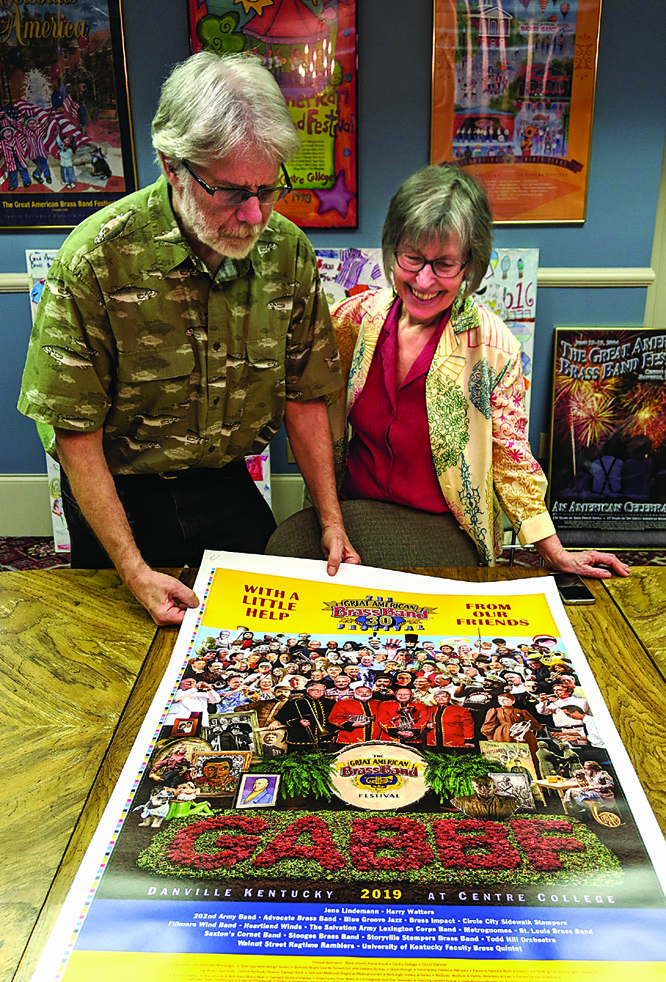 There should be no misunderstanding, however. The marathon endeavor was punctuated by many fortunate, often astonishing developments. One of our “Fab Four” individuals made a vital connection with an outstanding photographer in Athens, Georgia, who went the extra yard in matching my parameters for an important superimposition of the black-suited Dr Foreman. He also shot an antique bass drum to add another convincing Sgt Pepper’s touch — the same one that appeared on the festival’s first poster in 1990, and it still had the original, hand-painted emblem! Dana took the lead in preparing the poster “mechanical” for offset production, as she always has done for Dixon Design. She also knocked one out of the park during the solicitation of bids. As a contribution to the landmark production, Mike Abbott of Thoroughbred Printing agreed to produce the job at cost, and spent an hour with the press operator, Dana, and me, making sure we were satisfied with the quality.
There should be no misunderstanding, however. The marathon endeavor was punctuated by many fortunate, often astonishing developments. One of our “Fab Four” individuals made a vital connection with an outstanding photographer in Athens, Georgia, who went the extra yard in matching my parameters for an important superimposition of the black-suited Dr Foreman. He also shot an antique bass drum to add another convincing Sgt Pepper’s touch — the same one that appeared on the festival’s first poster in 1990, and it still had the original, hand-painted emblem! Dana took the lead in preparing the poster “mechanical” for offset production, as she always has done for Dixon Design. She also knocked one out of the park during the solicitation of bids. As a contribution to the landmark production, Mike Abbott of Thoroughbred Printing agreed to produce the job at cost, and spent an hour with the press operator, Dana, and me, making sure we were satisfied with the quality.
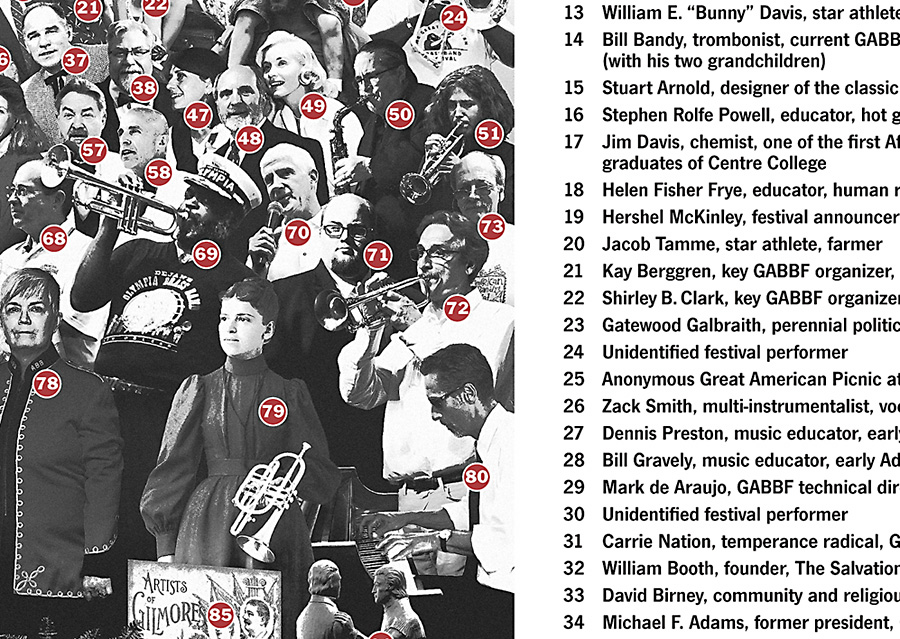 Our closing duty was to devise a printable key for identifying all the individuals and design elements. My original idea of including a longer “blurb” for each line item quickly became far-fetched when producing the abbreviated version dragged on. By the time we declared it done, the “labor of love” vibe had been exhausted. There wasn’t much love left in the air, and I just wanted all of it to hit the street, which it has, of course, and the positive response has been even more than I anticipated.
Our closing duty was to devise a printable key for identifying all the individuals and design elements. My original idea of including a longer “blurb” for each line item quickly became far-fetched when producing the abbreviated version dragged on. By the time we declared it done, the “labor of love” vibe had been exhausted. There wasn’t much love left in the air, and I just wanted all of it to hit the street, which it has, of course, and the positive response has been even more than I anticipated.
This post is already far too long, so I won’t get started on my Eva Marie Saint story, but I need to explain why we included a picture of the creators, and then I’ll finish up on an appropriate collage note. I was adamant that I would not fall prey to the Hitchcock Urge. I had no interest in, nor justification for, inserting myself, since I was making so many brutal choices to leave others on the cutting room floor. Dana was in total agreement, but the team of people who helped with the proofing process took an opposing viewpoint. Their collective drum beat was that the final rendition must include us! You can see that we eventually waved the white flag and stuck a small portrait on top of the Bourbon barrel.
A tiny figure seated at a kitchen table was provided by the Great American Dollhouse Museum as a nod to the Shirley Temple doll in the original composition, which also featured a Madame Tussauds wax figure of Sonny Liston on the opposite side. I knew there had to be a way to include Kentucky’s own Muhammed Ali in our version. Rather than take unavailable time to solicit permission to use a photograph that might get buried in the sea of faces, I turned to my friend Robert Hugh Hunt, who kindly let us insert the extraordinary collage portrait from his 20th Century Icons series!
Oh, I get by with a little help from my friends!
30th GABBF Poster
digital homage by Dana and John A Dixon
24 x 36 inches
Purchase one now!
Online order page includes a printable key to identification,
plus a ‘special thank you’ to all our essential collaborators!
Mar/X Four
Monday, March 4th, 2013Concentrating on miniatures seems right to me at this time, but a shift to larger works will be appropriate when I eventually get a solo show somewhere. I’ll enter the best of my current crop of small pieces in the “NOT-2-BIG” exhibition and submit a “miniature miniature” in Sherryl’s event in Yellow Springs. The satisfaction of producing Diamonds in the Rough is a restless call to scale up, and my larger works will probably continue to be more calculated than in the past. I’ll use that approach with my donation to the “Art-full Raffle” this year— something planned and executed specifically for that occasion. This gets to the heart of refining my process, using miniatures as a creative gateway to bigger, more complex ideas that deserve the investment of more time, not to mention a substantial sticker price. The challenge is to arrive at a methodology that fuses a mastery of style and technique with an outlook, a perspective, a “voice,” that delivers more than a sense of spontaneity and aesthetic unity, but a way of conveying something worth saying.
Gardenshapes by Kathleen
Saturday, July 28th, 2012“Beauty should be shared, for it enhances our joys.
To explore its mystery is to venture towards the sublime.”
―Joseph Cornell
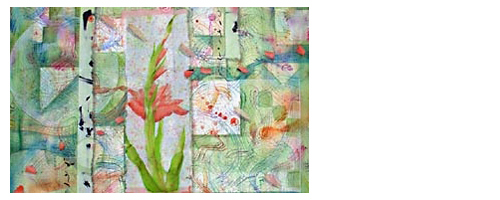
I hesitate to use a sports term to begin this review, but, since the Summer Olympics opened last night, I’ll set my disinclination aside to state emphatically that artist Kathleen O’Brien is at the top of her game!
Gardenshapes —an exhibition of her mixed-media collage finishing its run in the main gallery of Danville’s Community Arts Center— has ample proof to support my claim. I made one more return visit yesterday to experience the diverse subtleties of her singular creations.
Inspired by birds and flowers, and exploring the garden as a metaphor, this collection of artworks represents everything that has captivated me for years about Kathleen’s approach. These works have clearly grown out of how she thoughtfully observes and attunes with nature. They also literally contain and preserve natural ingredients. But in contrast to collage that maintains its focus on formal or intellectual juxtapositions, Kathleen’s art always nudges one toward a deeper sense of wholeness and the inner complexity of our balanced existence as both organic and spiritual beings. Without question, she has made a personal commitment to creating art as a mystical practice, and, on a communal level, to providing nature-inspired beauty as a source of healing in a fractured world.
With the strong presence of these intangible dimensions, Kathleen’s art is always esoteric, and yet she manages to make the work accessible to all with her choice of subject matter and allegiance to traditional drawing. At the same time, she can delight the eye of a fellow artist with her methodology, aesthetic choices, and pictorial skill. I’m not ashamed to admit that much of Kathleen’s symbolic virtuosity is beyond my ken, but I appreciate that it’s all in play at the intuitive level. Being near the prolific output of her creative life is simply uplifting, and that’s because all the facets of her art —whether conscious or subliminal— unify as a total perception to nourish the mind, heart, and soul.
Getting back to the show, I was initially struck by the five largest pieces (28 x 36 inches), beautifully presented against white in deep gallery-style frames of natural wood. This “look” is familiar to those who know Kathleen’s art, and enhances the work’s identity as an unique artifact, preserved behind glass, like a rare botanical or zoological specimen. They are titled with reference to the garden theme. In contrast, a separate piece (24 x 30 inches) is presented with its surface exposed in the manner of an easel painting. It looks equally at home, released from behind the glass, expertly varnished in a way that does not distract. Its name is Heaven & Earth, Yin & Yang, Dark & Light, Birds & Trees, Flowers & Bees. My eyebrows lifted as I began to read the lengthy title, but was pleased with the closing rhyme as I finished. This artist always has a quiet surprise in store. Each of the large works is visually distinctive, but very much a cohesive part of a series unified by her long dedication to compositional abstraction, to a consistent theory of color, and to diligent mark making.
The large piece titled Garden for Queen Anne’s Lace is marked by a cellular pattern resembling microscopic tissue, which, while remaining highly abstract, transforms itself into a flower garden, with an interesting emphasis on each “drop of Queen’s blood” that, when closely examined, becomes a dance of circles, squares, and triangles —a dynamic that exemplifies Kathleen’s knack for taking the observer/participant through layers of meaning. The design also incorporates the application of illustrated postage stamps. Kathleen is never far removed from a devotion to cultural references and ephemera, and her Joseph Cornell influences are ever present. A fine example of this are four pieces dedicated to bird-species (16 x 20 inches) that combine found printed patterns with her typical labor of liquid media. Nests are created with random shards and colorful scraps. Dried and painted star-like blossoms effectively merge the organic, symbolic, and celestial. In Kathleen’s collage there are many allusions to language, both literal and archetypal, and here we discover many fragments of the printed word, as well as her “trademark” calligraphy. I was particularly drawn to Garden for Blue Grosbeaks, a strong arrangement of symmetrical and asymmetrical elements that carries out more of her evident investigation into fundamental shapes —circle, square, and triangle. These compositions are anything but static, a characteristic of Kathleen’s art built on a myriad of ways in which she provokes eye movement by simulating the dynamic patterns of nature, often with the application of actual plants and minerals. A perfect case in point is 9 Bird Eggs (30 x 30 inches), with its nimble use of botanicals most artists would overlook as raw material, through which she creates a variety of rhythms within a formal, 3×3 grid structure.
I should mention that Kathleen’s control of what I call “implied viewing distance” is masterful. Enjoying her watercolor effects and hidden treasures up close is inevitably a satisfying experience, as is true with much of current small-scale mixed media collage, but her pieces also can be savored at a distance. I found myself continually studying a work from across the room and then, taking off my eye-wear, sticking my nose near the glass to examine fine detail. Whether from this point of view or from half a block away, Kathleen’s distinctive impression is always recognizable, an enviable accomplishment for any artist. For example, both Royal Lily Garden and Staple Garden contain brushwork that only can be achieved by someone who is continuously handling liquid on a tool and is fully at ease with her surface. On the other hand, she uses this micro-fluency to create the intended multi-layered depth of her macro-composition, and yet I was constantly invited to step back into the intimacy of the picture plane, much as one feels when standing back to admire a flower garden, while being compelled to converge at hand’s length, only to spy a miniature surprise —a dutiful pollinator or tiny feat of nature’s diversity within repetition.
With my fixation on the bigger paintings, it was too easy to neglect the smaller items, so I had to instruct myself to visually isolate and appreciate several other works. Two of these were within squares, and each have treatments not as pronounced elsewhere in the exhibition. Feathers uses paper itself as a dimensional medium, and The Blessing of Rain features a darker atmospheric background —a shimmering chalk texture that makes me wish Kathleen would more intensively explore the potential of pastel effects. In addition, there are three bird portraits (9 x 12 inches), with coatings of what appeared to be beeswax, which recall for me the investigations of 19th-century naturalists. My favorite is Garden for Eastern Bluebirds, with its deft pencil work and luscious color palette. Kathleen pushes her highly capable layering beyond technique to create a sense of time distortion, an interplay of wildlife and cultural antiquity that makes certain the work is much more than a lovely rendering of birds. Throughout this outstanding show are many such allusions to natural and human-made cycles that fuse the worlds of growing things and a striving race that has always responded with symbolic culture to seek a balanced place in the scheme of life.
Indeed, Kathleen O’Brien has found her place. With a home studio close to nature, and a creative passion that distills her observations and meditations through heart, head, and hand, she is a gold-medal artist of the soul.
© 2012, John Andrew Dixon
Garden for Eastern Bluebirds and Garden for Scarlet Tanagers
by Kathleen O’Brien
Tribal Monday the First
Monday, May 7th, 2012Kathleen and I inaugurated our two-person discussion group this afternoon. The first thing I noticed was how tranquil a space she has created as a “shrine” for her artistic dedication. One can truly listen to the heart in such a studio, and I appreciate her willingness to share it for a couple hours. For me the sense of place at Sunwise Farm is inseparable from Kathleen’s mixed media collage. The fullness of her artwork is about energy, and this energy—with the powerful intention it carries—is tied in some significant way to a field of Light that is carefully nurtured for optimum receptivity and intuition. I have long admired the way in which she maintains the uplifting focus of her art, an essence that is recognizable at fifty paces, and how her respect for the process is embodied in her bright, organized, efficient studio. What an inspiration for someone who seems caught in a perpetual struggle to concentrate, prioritize, and decisively press forward with a more streamlined vision.
Book of Light, page 171 by Kathleen O’Brien
www.kathleen-obrien.com
2003 – 2011
Thursday, May 5th, 2011Brendan concluded his micro-fiction project on Tuesday, after nearly eight years of creative ritual. Some new gigs are certain to fill the vacuum as he enters his fourth decade, and I expect to enjoy the product just as much. Anacrusis has been my Thunderbird home page for a long time. 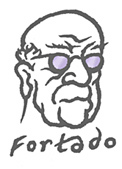 I don’t expect that to change at this point, but I’ll miss that daily curiosity until I finally get used to it, and yet I fully understand and appreciate his desire for resolution. Except for the rare Fred Rogers or Charles Schultz, few things are forever, and an artist really doesn’t need to explain each transition. Nevertheless, I appreciate the epilogue and accept his word of thanks. As for any debt, I’d say we’re more than even, after so many smiles, throat lumps, and catalytic jolts to my hair-trigger imagination. It’s an awesome body of work worthy of pride, NB, and I don’t doubt that others will be mining it for ideas well into the future. Good luck!
I don’t expect that to change at this point, but I’ll miss that daily curiosity until I finally get used to it, and yet I fully understand and appreciate his desire for resolution. Except for the rare Fred Rogers or Charles Schultz, few things are forever, and an artist really doesn’t need to explain each transition. Nevertheless, I appreciate the epilogue and accept his word of thanks. As for any debt, I’d say we’re more than even, after so many smiles, throat lumps, and catalytic jolts to my hair-trigger imagination. It’s an awesome body of work worthy of pride, NB, and I don’t doubt that others will be mining it for ideas well into the future. Good luck!
